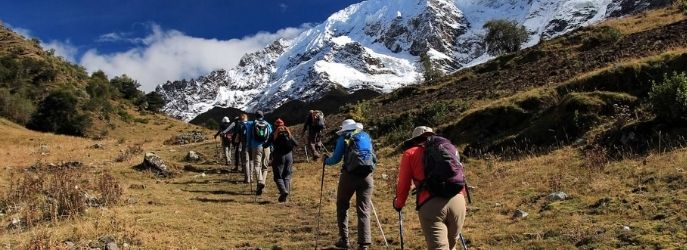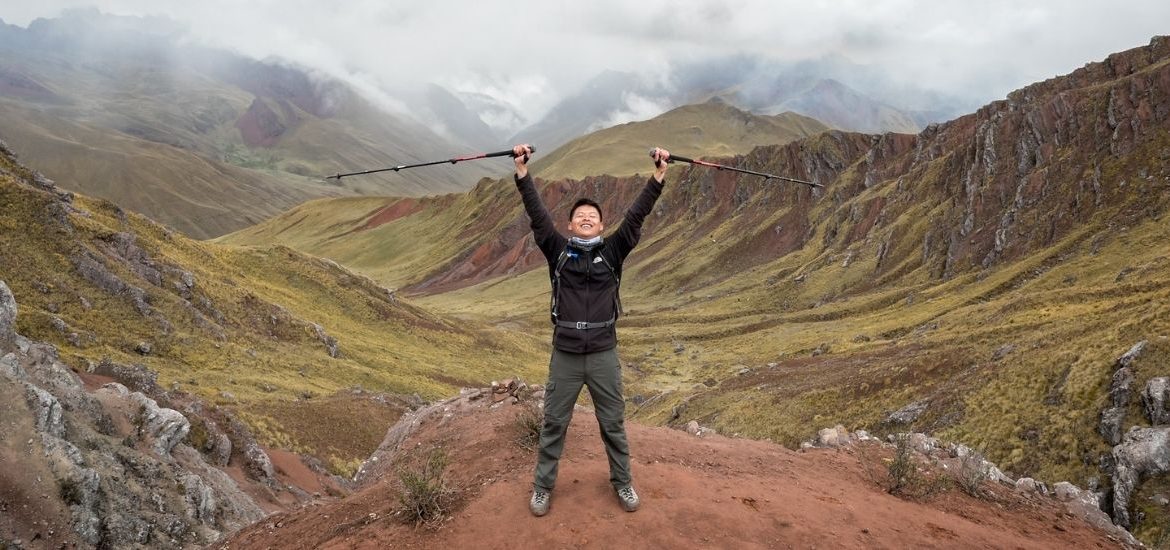Since Peru is a geographically diverse country, the altitude varies according to its regions and some of the most in-demand destinations of the country are located over 3,000 meters above sea level. Therefore, if you’re visiting the Peruvian Andes, here are some recommendations so you can avoid altitude sickness during your trip.
For those who may not know much about this condition, altitude sickness affects most people that come from sea level to altitudes that surpass the 1,000 meters of elevation. Regardless of your physical condition or age, it could hit you at any time and if not treated right away it might even ruin your travel itinerary.
As we have mentioned in different blogs, we don’t mean to scare you off by pointing this out, but to make things easier for you while traveling through Peru. For that reason, we have come up with this section so you get to know about the most intelligent way to approach altitude according to your itinerary.
Before getting into full detail, we want to explain a bit more about the altitude sickness symptoms and how to prevent it in case you’re jumping right into Cusco, Puno or Arequipa just after arriving in Lima.
About Altitude Sickness
When traveling to high-altitude locations keep in mind that the air pressure will be lower, which makes you feel as if the air you breathe is getting ‘thinner.’ That is very common when you’ve been living in a low-altitude place for so long that an increase in altitude could cause you to feel symptoms of altitude sickness.
As your body is used to a certain level of air pressure, once you go higher you might experience shortness of breath, tiredness, mild headaches and even dizziness. That’s when you need to take some time so your body adapts to these new conditions.
As we mentioned above, you could start experiencing altitude sickness at places that sit at an elevation of 1,000 meters or much more. Symptoms are usually felt within the first 12-14 hours upon arrival and can even last for 3 days if not taken care of.

There are three kinds of altitude sickness, the most common in Peru is Acute Mountain Sickness, which is experienced very mildly and the symptoms feel like a hangover. However, depending on how your body reacts to low-oxygen levels, you can experience a more severe condition though it occurs less frequently.
For example, altitude sickness can be related to high-altitude pulmonary edema (HAPE), which causes an excess of fluids on the lungs. In the worst case, it can even escalate to high-altitude cerebral edema (HACE), which can be life threatening.
Having that in thought, we’d like to highlight that it’s always best to consult with your doctor before heading to a high-altitude location, especially if having pre-existent pulmonary diseases.
How to Prevent and Deal with Altitude Sickness
As you already know a bit more about this condition and the effects it can have on your body, here we have gathered some tips so you can successfully prevent altitude sickness symptoms. Luckily, not everyone gets to experience it, but it’s always best to be cautious rather than losing a few days from your itinerary.
- Keep yourself hydrated
The water will be your best ally to fight and prevent this condition, so make sure to drink enough liquid throughout your stay. Higher altitudes are associated with dehydration as a result of dryer air and more rapid breathing, causing a greater loss of bodily fluids.
- Avoid alcohol and smoking at all costs
Yes, we know this is hard and even worse if you’re on vacation but trust us, it’s best to wait at least 48 hours before drinking alcohol or smoking. These could worsen dehydration and shortness of breath if ingested on the first days of your stay.
- Drink Coca tea or chew Coca leaves
The Coca plant is a medicinal herb used since pre-Columbian times. It is known for helping to ease any altitude sickness symptoms and improving acclimatization. You can either drink tea or just chew on the leaves.
- Eat a light but high-calorie diet
Higher altitudes increase our need for fuel, which is why it is best to have a calorie-based diet. Make sure to eat healthy snacks including lots of whole grains in your meals.
- Take it easy
The key to everything in life! Don’t rush yourself, take the necessary time to get used to the altitude and don’t do any physically demanding activities during your first days. In the meantime, you can take a walking tour through the city you’re visiting or just rest.
If you’re wondering if there are any medicines that can help you with the altitude sickness symptoms, you could buy Diamox or Soroche Pills from any drugstore in Peru. However, we recommend consulting with a doctor first before taking any of these medications.
The Best Way to Approach Altitude in Peru

If your itinerary takes you on a long journey through Peru, then the best way to approach altitude would be by bus. That way, you’ll be ascending gradually and your body will have time to adapt itself to the low-oxygen levels.
Luckily for you, we have structured all our travel packages thinking about that. Either you take a 5-day experience in Cusco or a 17-day itinerary through southern Peru, we’ll give you time so you can get properly acclimatized.
However, if you’re wondering about the main thing in this blog, here’s the best Peru itinerary to avoid altitude sickness:
- Lima
If flying from abroad, Lima will be the starting point of your adventure. Although most travelers tend to overlook our marvellous capital, we always encourage our passengers to take some time to experience the best of our gastronomy there, as well as the impressive historical heritage it gathers.
Lima is not only a busy capital in South America since it also comprises an outstanding colonial center and many archeological sites that you wouldn’t like to miss. Nonetheless, even if you stay 24 hours in Lima, you’ll be able to experience some of the best attractions of the city.
The so-called City of Kings is the starting point for most foreign tourists visiting southern Peru, but we’ll leave it up to you if you’d like to skip it and make your way down through the country upon arrival. - Ica
One of the reasons for staying in Lima for one day is so you can catch an early bus to Paracas, a beach town located a couple of hours away from the bustling capital. Paracas is part of the Ica region and gathers two natural wonders that you wouldn’t like to miss such as the Paracas National Reserve and the Ballestas Islands.
You can choose to visit either of those attractions and later head down to the only natural oasis in South America, Huacachina. This deep-green lagoon is located in the middle of the Peruvian desert, surrounded by towering sand dunes where you can do the Dune Buggy and Sandboarding Tour.
We would recommend taking a break in Huacachina or the city of Ica so you can rest, otherwise it would be a very long and exhausting trip. The next morning you can do the Pisco Route and get to know everything about the traditional and modern distillery processes of wine and pisco, our national drink.
Afterwards, you can head down to Nazca and experience one of the most impressive mysteries of the ancient world: The Nazca Lines. Or, you can continue your trip to the White City of Arequipa. - Arequipa
This will be your entrance to the Peruvian Andes since this magical city is located at 2,335 meters above sea level. However, if you come on a bus ride to Arequipa, you’d have ascended gradually and slowly and you will be less likely to experience any altitude sickness symptoms.
Arequipa is the second-largest city of Peru and holds an authentic historic center, which some say is the most visually striking colonial urban scenery of Peru. There are so many things to do in the White City, and if you love nature as much as we do, you’ll surely won’t let this destination out of your itinerary.
Likewise, the Colca Canyon is the main attraction here! Its altitude can reach up to 4,000 m.a.s.l. and you can visit it on a 2-day tour or, if you’re feeling adventurous, by taking a 2-3 day trek. If you’re wondering what to do next, Puno is just around the corner from this natural wonder, so you can either go back to Arequipa or continue your trip towards the highest navigable lake in the world! - Puno
Also known as the Folkloric Capital of Peru, it is a beautiful andean city, located at the banks of Lake Titicaca. The city sits on an elevation of 3,827 meters above sea level and offers the best cultural experience in the country.
The main attraction here is the lake since it gathers a millenary culture and the Floating Islands of Uros, a group of over 100 artificial islands made entirely of totora reed. Here you’ll get to know one of the oldest communities of Peru, while also being totally surrounded by impressive natural sceneries and ancient mysticism.
Besides the floating utopy, Lake Titicaca has two more islands that have opened their doors to tourism. The Amantani Island for example is the perfect destination to get involved in the local daily lives of its inhabitants since it allows tourists to have a homestay experience right at the heart of the lake. - Cusco
By making your way to Cusco by bus, you’ll be able to visit even more archeological sites and natural wonders on the way. Take the Ruta del Sol tour, the best alternative to get to Cusco from Puno on a day trip.
Once in Cusco (located at 3,399 m.a.s.l.), you won’t have any trouble with altitude sickness since your body would be already used to it. However, it is very likely that you could still experience shortness of breath, which believe us, it happens to most people that live there but not to a greater extent.
The so-called Imperial City of the Incas is the main attraction here and the most complete travel destination in Peru. Here you’ll be able to visit Machu Picchu but also getting to know the history of the Inca in the very heart of the ancient empire. Check this guide for more information about the best day trips from Cusco.
As you can see, there’s so much to know in Peru that you would love to experience it all during your trip. If you’d like to visit other sites rather than the aforementioned, our local experts can help you with that and much more. Contact us now and we can organize a tailor-made itinerary just for you, and most importantly, according to your interests.

